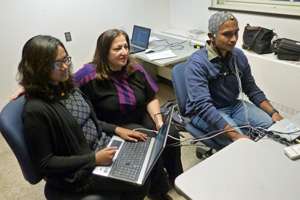Building block for exoskeleton could lead to more independence among the elderly (w/ Video)

What if certain patients could get a bionic pick-up without undergoing the pain and lengthy recovery of surgery? University of Cincinnati researchers are working on just that idea, with the start of an exoskeleton to support people who – through age or injury – are limited in their movement.
Gaurav Mukherjee, a UC master's student in mechanical engineering in UC's College of Engineering and Applied Science (CEAS), will present the interdisciplinary research on Nov. 15, at the International Human-Centered Robotics Symposium, which will be held at UC's Kingsgate Marriott Conference Center.
Working with a senior student design team in mechanical engineering, Mukherjee and Grant Schaffner, an assistant professor in UC's Department of Aerospace Engineering and Engineering Mechanics, designed and built a spring-assisted leg exoskeleton that can help people stand and sit. Further research partnerships with Shikha Chaganti, a master's degree student in computer science, and her advisor, Anca K. Ralescu, a UC professor of computer science, are examining how a brain-computer interface can interpret how to operate the exoskeleton with what the user wants to do.
Mukherjee says that a movement analysis study has been underway in the lab – using markers on the body to build a virtual model. The results of the experiment can help researchers design the exoskeleton to supplement the capability of the user.
Additionally, researchers are exploring muscle activity to produce a suit that will work in cooperation with the natural movement of the patient/user, rather than forcing a predetermined motion.
Mukherjee says the exoskeleton could hold promise for the nation's aging Baby Boomer population, adding that as many as 3 million American senior citizens currently require some form of nursing supervision. The interdisciplinary research is hoped to one day benefit geriatric patients, patients affected by stroke and paraplegics, in gaining independence in movement.
The exoskeleton research is a collaboration with the College of Engineering and Applied Science's Department of Aerospace Engineering and Engineering Mechanics, Department of Electrical Engineering and Computing Systems and the UC College of Nursing.
Future research will involve further development of the exoskeleton in building supports to enable movement of ankles and hips, as well as developing better fluidity in movement.
Provided by University of Cincinnati



















